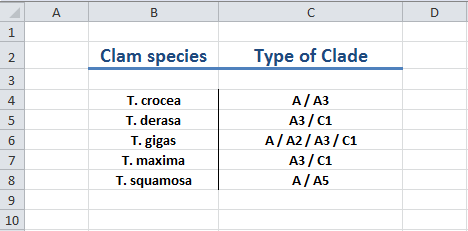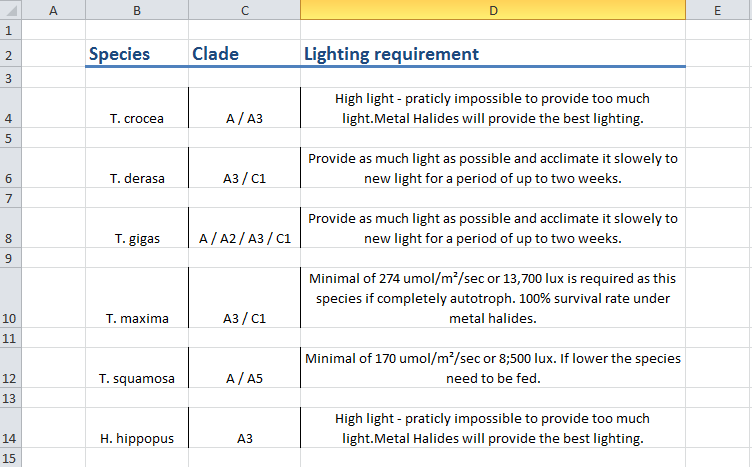ReefingFun
Member
Hey everyone,
For the last 6 months I have been doing some reading on clams. At first to see if I can have them in my aquarium, but after a while it became more for general interest. There is no denying that these creatures are very unique, both in biology as in looks.
Recently my grandmother, who is a professor biology at the university Leuven, decided to help me out in my research and came across a very interesting article.
The article probably got published somewhere without a doubt, as many aquarists (and others) will love the information it contains.
I thought some of you might be interested in this and as such I compiled the most relevant data from the article(s) for you. Now I did not come up with these results myself. The research is done by several people and organisations and I'm not a part of them. I merely summarized their work for you.
So here goes! Enjoy the read
-------------------------------------------------------
Tridacnids & Lighting
Introduction
First and foremost it is important to understand some key concepts about clams.
Clams are autotrophic, which means that they don't need to feed to be self-sufficient. In normal conditions, they will receive enough nutriments from their zooxanthellae, which is a symbiotic relation.
When those zooxanthellae receive enough light to produce enough oxygen to meet the clam's requirements, we speak of the compensation point. Though the opposite can happen as well. When there is an abundance of light and the zooxanthellae have absorbed the maximum capacity of light, they call it the saturation point.
The saturation point is equally important as the compensation point. Unlike some might believe, a clam or actually the zooxanthellae, can get too much lightning. When they get too much lighting for a longer period of time and the zooxanthellae reached their saturation point, they might get damaged in a process called chronic photoinhibition. Important here is that this only happens when the light is too strong for a longer period of time, hence the word "chronic".
The zooxanthellae formed a clever solution to deal with "light bursts" after reaching their saturation point and protect themselves from getting damaged. This process is called dynamic photoinhibition.
For those wanting to skip this part, just scroll down as it might get a bit "technical" now.
Dynamic photoinhibition is a very important relief system for the zooxanthellae. Zooxanthellae have two types of xanthophylls, which are - without going too much in depth - a form of agents that protect them from forming too much triplet chlorophyll (form of chlorophyll that is overproduced at high light levels in photosynthesis). They do this by shifting away a part of the blue light spectrum.
Another form of protection is the MAAs. Mycosporinelike amone acids (protein group) protect the photosynthetic organisms from getting damaged by ultraviolet radiation.
Speaking of radiation, perhaps this is a good time to explain PAR or photosynthetically active radiation. PAR is a very important term. You will see it mentioned in almost every topic that deals with lighting for aquariums.
PAR is simply the radiation that promotes photosynthesis and falls between ~ 400 nanometers and 700 nm.
Understanding the zooxanthellae
Over the years, researchers have discovered that there are several clades (group of organisms that have evolved from a common ancestor - wikipedia) of zooxanthellae. There are over 100 different clades of zooxanthellae, but only 7 are relevant to the T.Clams.
The following clades are present in the Tridacna clam's tissue: A, A2, A3, A3a, A5, A6 and C1. These are not all hosted within 1 of the Tridacna species. A table below shows the different T.species and their clade(s). By knowing which species have which clade, you can determine what light / environment the clam favors, as each clade favors different things.

Now we only have to define what the different clades favor and what the compensation / saturation points are and we know what conditions the hosting clam favors.
Clade A
This is the general group of the different clades A. Clade A hosts are mostly found in the Caribbean. Clade A is the the ancestor to all the others.
They are very hardy compared to the rest.
Below I will list the different A clades, with their depth ranges and their light adaptations.
Clade A2
Depth range: 33 feet or less
Location range: Pacific and Carribean
Light adaptation: High lighting required. These do not adapt very well to low lighting and will do poorly.
Temperate swings are tolerated.
Clade A3
Depth range: 7 to 49 feet
Location range: Pacific and Atlantic
Light adaptation: High lighting tolerant, but will do fairly well in lower levels of lighting as well. They have MAAs to absorb ultraviolet radiation.
They cannot stand low temperatures(50.9°F).
Clade A3a
Depth range: not known with certainty and as such not posted
Location range: Philippines
This clade type is only found in yet unidentified species.
Clade A5
Depth range: not known with certainty and as such not posted
Location range: Palau
Only found in T. squamosa
Clade A6
Depth range: 3 to 33 feet
Location range: Philippines and Okinawa
Light adaption:
Clade C1
Depth range: up to 65 feet
Location range: Great Barrier Reef, Bahamas, Japan, Korea, Atlantic and Indonesia
Light adaption: Unknown
Now that we know the Clades we only need to define what the saturation and compensation points are of the different species and the moment we all been waiting for.
Species lighting requirements
I will simply show the excel spreadsheet I made, makes it easier for you to have an overview ( and ofc for me as my fingers are hurting at this point!)

As you can see, most if not all species do better under medium to high lighting. If minimal requirements are not meet, the clam will not absorb nutrients out of nitrate and phosphates and as such will require extra filter feeding.
I hope you found it an interesting read and hopefully you learned something new.
Enjoy your clams!
For the last 6 months I have been doing some reading on clams. At first to see if I can have them in my aquarium, but after a while it became more for general interest. There is no denying that these creatures are very unique, both in biology as in looks.
Recently my grandmother, who is a professor biology at the university Leuven, decided to help me out in my research and came across a very interesting article.
The article probably got published somewhere without a doubt, as many aquarists (and others) will love the information it contains.
I thought some of you might be interested in this and as such I compiled the most relevant data from the article(s) for you. Now I did not come up with these results myself. The research is done by several people and organisations and I'm not a part of them. I merely summarized their work for you.
So here goes! Enjoy the read
-------------------------------------------------------
Tridacnids & Lighting
Introduction
First and foremost it is important to understand some key concepts about clams.
Clams are autotrophic, which means that they don't need to feed to be self-sufficient. In normal conditions, they will receive enough nutriments from their zooxanthellae, which is a symbiotic relation.
When those zooxanthellae receive enough light to produce enough oxygen to meet the clam's requirements, we speak of the compensation point. Though the opposite can happen as well. When there is an abundance of light and the zooxanthellae have absorbed the maximum capacity of light, they call it the saturation point.
The saturation point is equally important as the compensation point. Unlike some might believe, a clam or actually the zooxanthellae, can get too much lightning. When they get too much lighting for a longer period of time and the zooxanthellae reached their saturation point, they might get damaged in a process called chronic photoinhibition. Important here is that this only happens when the light is too strong for a longer period of time, hence the word "chronic".
The zooxanthellae formed a clever solution to deal with "light bursts" after reaching their saturation point and protect themselves from getting damaged. This process is called dynamic photoinhibition.
For those wanting to skip this part, just scroll down as it might get a bit "technical" now.
Dynamic photoinhibition is a very important relief system for the zooxanthellae. Zooxanthellae have two types of xanthophylls, which are - without going too much in depth - a form of agents that protect them from forming too much triplet chlorophyll (form of chlorophyll that is overproduced at high light levels in photosynthesis). They do this by shifting away a part of the blue light spectrum.
Another form of protection is the MAAs. Mycosporinelike amone acids (protein group) protect the photosynthetic organisms from getting damaged by ultraviolet radiation.
Speaking of radiation, perhaps this is a good time to explain PAR or photosynthetically active radiation. PAR is a very important term. You will see it mentioned in almost every topic that deals with lighting for aquariums.
PAR is simply the radiation that promotes photosynthesis and falls between ~ 400 nanometers and 700 nm.
Understanding the zooxanthellae
Over the years, researchers have discovered that there are several clades (group of organisms that have evolved from a common ancestor - wikipedia) of zooxanthellae. There are over 100 different clades of zooxanthellae, but only 7 are relevant to the T.Clams.
The following clades are present in the Tridacna clam's tissue: A, A2, A3, A3a, A5, A6 and C1. These are not all hosted within 1 of the Tridacna species. A table below shows the different T.species and their clade(s). By knowing which species have which clade, you can determine what light / environment the clam favors, as each clade favors different things.

Now we only have to define what the different clades favor and what the compensation / saturation points are and we know what conditions the hosting clam favors.
Clade A
This is the general group of the different clades A. Clade A hosts are mostly found in the Caribbean. Clade A is the the ancestor to all the others.
They are very hardy compared to the rest.
Below I will list the different A clades, with their depth ranges and their light adaptations.
Clade A2
Depth range: 33 feet or less
Location range: Pacific and Carribean
Light adaptation: High lighting required. These do not adapt very well to low lighting and will do poorly.
Temperate swings are tolerated.
Clade A3
Depth range: 7 to 49 feet
Location range: Pacific and Atlantic
Light adaptation: High lighting tolerant, but will do fairly well in lower levels of lighting as well. They have MAAs to absorb ultraviolet radiation.
They cannot stand low temperatures(50.9°F).
Clade A3a
Depth range: not known with certainty and as such not posted
Location range: Philippines
This clade type is only found in yet unidentified species.
Clade A5
Depth range: not known with certainty and as such not posted
Location range: Palau
Only found in T. squamosa
Clade A6
Depth range: 3 to 33 feet
Location range: Philippines and Okinawa
Light adaption:
Clade C1
Depth range: up to 65 feet
Location range: Great Barrier Reef, Bahamas, Japan, Korea, Atlantic and Indonesia
Light adaption: Unknown
Now that we know the Clades we only need to define what the saturation and compensation points are of the different species and the moment we all been waiting for.
Species lighting requirements
I will simply show the excel spreadsheet I made, makes it easier for you to have an overview ( and ofc for me as my fingers are hurting at this point!)

As you can see, most if not all species do better under medium to high lighting. If minimal requirements are not meet, the clam will not absorb nutrients out of nitrate and phosphates and as such will require extra filter feeding.
I hope you found it an interesting read and hopefully you learned something new.
Enjoy your clams!

